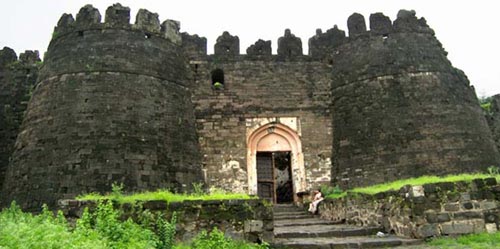Daulatabad Fort

Information on Daulatabad Fort (Aurangabad, Maharashtra) - History & Architecture
Exclusive magnitude of architecture which is classified by the strong fortification of Daulatabad Fort was not just renowned for protecting the surroundings from external aggression but its eccentric grandeur and transposable character makes it astounding and historical. An isolated landscape that compliments structures of Daulatabad fort is located perfectly within the city of Maharashtra and its fortification that compiles distinct concentric lines still revere the phase of medieval period when colonization and annexation were a part of administration.
Daulatabad Fort Architecture
The 12th century fort of Daulatabad which is located within the tranquility of isolated cone shaped hill is renowned for its architectural brilliance the bastions which is placed at the height of 200 m speaks the volume of defensive strategies. The concentric wall which was designed to keep the impostor at the bay is complimented by spiked gates, deep moat and graveled sideways. The series of secrets escapes and subterranean passages within the wall made this impenetrable and impermeable. The 5 km thick wall along with artificial scarping still makes the site imposing and historical. The octagonal shaped Baradari stands near the summit beside that, three rooms of artillery defines the strategy of offensive skills.
Within the wall of the fort the classified monuments of Daulatabad, Chand Minar, Jami Masjid and royal palaces speaks the volume of wisdom. All the three monuments are designed beautifully with halls, pavilions and courtyards which in turn would give you insight idea regarding their architectural stands.
Daulatabad Fort History
According to narrative accounts the city was discovered by Bhillama V during the call of 11th century. It is believed that his commitment with Chalukyas was denounced and soon after that he established Yadava Dynasty in the western territory of the city. Daulatabad which is also renowned as the abode of wealth came into highlights after the annexation of the fort by Muhammad-bin-Tughluq, it is believed that he was so impressed by the structure of the fort that he decided to shift his capital from Delhi to Daulatabad which proved to be fatal anyways but his historical move which was practiced during the 13th century made the fort famous and popular.
It was during the administrative phase of Yadava the city was renowned as Deogiri which means hill of gods. It is believed that Yadavas during the initial phase practiced their power under the subjugation of Chalukyas but then Bhillama V led glorious campaigns against Hoysalas. During the throne of Ramachandradeva, Ala-ud-Din Khilji led the invasion and annexed Deogiri during 12th century but then again he was allowed to rule till Malik Kafur showed external aggression against Ramachandradeva and his son Shankardeva during 13th century. After Malik Kafur, Qutb-ud-din Mubarak Shah Khilji invaded the site and annexed Deogiri to the Delhi Sultanate. After the phase of Delhi Sultanate the horizons of Deccan witnessed the powers of Mughal and Marathas and then again Daulatabad came under the rule of Nizams of Hyderabad till the time of Indian independence.
We must understand that when it comes to establishment and construction of the fort then we must remember to give credit to Raja Bhillamraj of Yadava dynasty. Its impressive bastions and fortification from security point of view enticed warrior dynasties from different part of the world.
Daulatabad Fort Tourism Importance
To define the brilliance of Daulatabad Fort from tourism point of view traveler would require driving here because an eternal stands and the classified walls and sections of the fort would reveal the glory of the medieval days. An essence of narrative accounts and transfer of power from one dynasty to another can be sensed while standing at the periphery of the wall.
- Ahmednagar Monuments
- Akola Monuments
- Amravati Monuments
- Aurangabad Monuments
- Dhule Monuments
- Kolhapur Monuments
- Latur Monuments
- Mumbai Monuments
- Nagpur Monuments
- Nashik Monuments
- Palghar Monuments
- Pune Monuments
- Raigad Monuments
- Ratanagiri Monuments
- Satara Monuments
- Sindhudurg Monuments
- Thane Monuments
- Andaman Nicobar Monuments
- Andhra Pradesh Monuments
- Assam Monuments
- Bihar Monuments
- Chhattisgarh Monuments
- New Delhi Monuments
- Goa Monuments
- Gujarat Monuments
- Haryana Monuments
- Himachal Pradesh Monuments
- Jammu and Kashmir Monuments
- Karnataka Monuments
- Kerala Monuments
- Madhya Pradesh Monuments
- Maharashtra Monuments
- Odisha Monuments
- Punjab Monuments
- Rajasthan Monuments
- Tamil Nadu Monuments
- Telangana Monuments
- Uttar Pradesh Monuments
- West Bengal Monuments